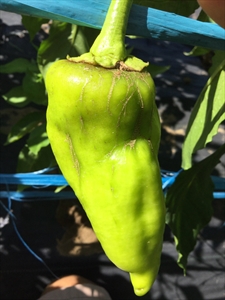- Worldwide distribution. A problem of many plant families - cabbages, cucumber, legume, potato, ornamentals, and weeds.
- Feed on undersides of leaves, which become silvery or brown, and curl. Feeding on fruit when it is young produces scars when the fruit expands.
- Spreads viruses, e.g., Tomato spotted wilt virus is widespread and important (not reported from Pacific island countries).
- Cultural control: avoid planting near older crops; nurseries far from production areas and/or use thrips-proof netting; weed before planting; at harvest, collect trash and burn. For the control of TSWV use resistant varieties.
- Chemical control: use soaps, oils, neem, or spinosad.








